Teresa Serrano-Gotarredona
Alex
Roadmap to Neuromorphic Computing with Emerging Technologies
Jul 02, 2024



Abstract:The roadmap is organized into several thematic sections, outlining current computing challenges, discussing the neuromorphic computing approach, analyzing mature and currently utilized technologies, providing an overview of emerging technologies, addressing material challenges, exploring novel computing concepts, and finally examining the maturity level of emerging technologies while determining the next essential steps for their advancement.
Semantic segmentation for recognition of epileptiform patterns recorded via Microelectrode Arrays in vitro
Feb 12, 2024



Abstract:Epilepsy is a prevalent neurological disorder that affects approximately 1% of the global population. Around 30-40% of patients do not respond to pharmacological treatment, leading to a significant negative impact on their quality of life. Closed-loop deep brain stimulation (DBS) is a promising treatment for individuals who do not respond to medical therapy. To achieve effective seizure control, algorithms play an important role in identifying relevant electrographic biomarkers from local field potentials (LFPs) to determine the optimal stimulation timing. In this regard, the detection and classification of events from ongoing brain activity, while achieving low power through computationally unexpensive implementations, represents a major challenge in the field. To address this challenge, we here present two lightweight algorithms, the ZdensityRODE and the AMPDE, for identifying relevant events from LFPs by utilizing semantic segmentation, which involves extracting different levels of information from the LFP and relevant events from it. The algorithms performance was validated against epileptiform activity induced by 4-minopyridine in mouse hippocampus-cortex (CTX) slices and recorded via microelectrode array, as a case study. The ZdensityRODE algorithm showcased a precision and recall of 93% for ictal event detection and 42% precision for interictal event detection, while the AMPDE algorithm attained a precision of 96% and recall of 90% for ictal event detection and 54% precision for interictal event detection. While initially trained specifically for detection of ictal activity, these algorithms can be fine-tuned for improved interictal detection, aiming at seizure prediction. Our results suggest that these algorithms can effectively capture epileptiform activity; their light weight opens new possibilities for real-time seizure detection and seizure prediction and control.
A Memristor-Inspired Computation for Epileptiform Signals in Spheroids
Jul 10, 2023



Abstract:In this paper we present a memristor-inspired computational method for obtaining a type of running spectrogram or fingerprint of epileptiform activity generated by rodent hippocampal spheroids. It can be used to compute on the fly and with low computational cost an alert-level signal for epileptiform events onset. Here, we describe the computational method behind this fingerprint technique and illustrate it using epileptiform events recorded from hippocampal spheroids using a microelectrode array system.
* published in 2023 IEEE 5th International Conference on Artificial Intelligence Circuits and Systems (AICAS)
Foveal-pit inspired filtering of DVS spike response
May 29, 2021
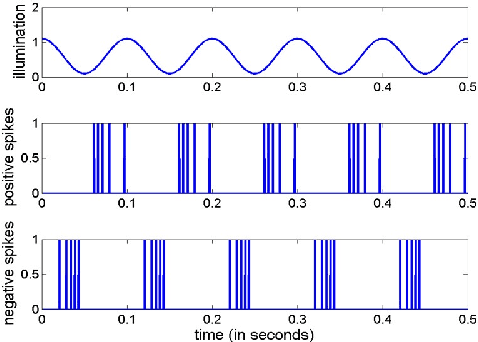
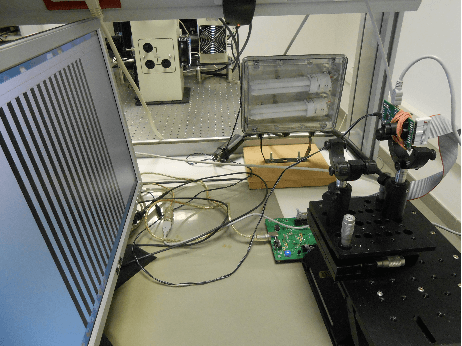
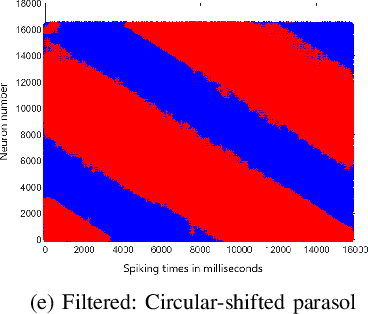
Abstract:In this paper, we present results of processing Dynamic Vision Sensor (DVS) recordings of visual patterns with a retinal model based on foveal-pit inspired Difference of Gaussian (DoG) filters. A DVS sensor was stimulated with varying number of vertical white and black bars of different spatial frequencies moving horizontally at a constant velocity. The output spikes generated by the DVS sensor were applied as input to a set of DoG filters inspired by the receptive field structure of the primate visual pathway. In particular, these filters mimic the receptive fields of the midget and parasol ganglion cells (spiking neurons of the retina) that sub-serve the photo-receptors of the foveal-pit. The features extracted with the foveal-pit model are used for further classification using a spiking convolutional neural network trained with a backpropagation variant adapted for spiking neural networks.
Experimental Body-input Three-stage DC offset Calibration Scheme for Memristive Crossbar
Mar 03, 2021
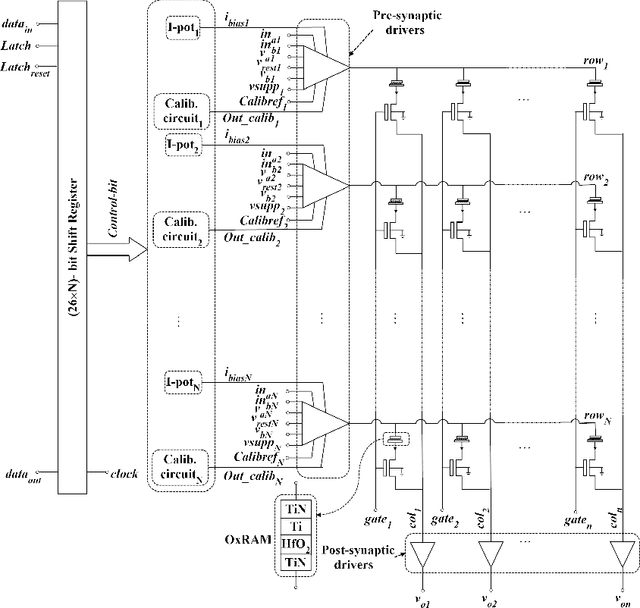
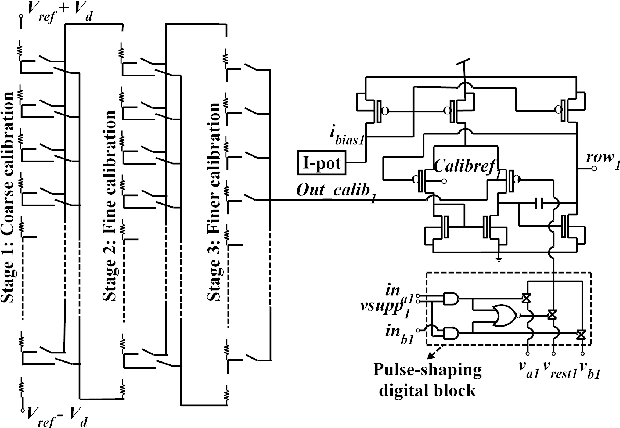

Abstract:Reading several ReRAMs simultaneously in a neuromorphic circuit increases power consumption and limits scalability. Applying small inference read pulses is a vain attempt when offset voltages of the read-out circuit are decisively more. This paper presents an experimental validation of a three-stage calibration scheme to calibrate the DC offset voltage across the rows of the memristive crossbar. The proposed method is based on biasing the body terminal of one of the differential pair MOSFETs of the buffer through a series of cascaded resistor banks arranged in three stages: coarse, fine and finer stages. The circuit is designed in a 130 nm CMOS technology, where the OxRAM-based binary memristors are built on top of it. A dedicated PCB and other auxiliary boards have been designed for testing the chip. Experimental results validate the presented approach, which is only limited by mismatch and electrical noise.
 Add to Chrome
Add to Chrome Add to Firefox
Add to Firefox Add to Edge
Add to Edge